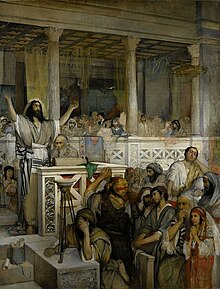Maurycy Gottlieb
Maurycy Gottlieb (born February 21 or 28, 1856 in Drohobytsch , Galicia , Austrian Empire ; died July 17, 1879 in Cracow , Austria-Hungary ) was a Polish painter of the Jewish faith who was close to the Haskala . Although he was only 23 years old, he left around 300 paintings, most of them in an unfinished state.
Life
At the age of 15 he began studying painting at the Academy of Fine Arts Vienna , then went to Krakow to continue his studies with Jan Matejko . Because of the anti-Semitism of his fellow students, he left Krakow after less than a year and went back to Vienna . Study trips also took him to Munich and Rome .
While his early pictures had nationalistic Polish subjects, he soon turned to Jewish subjects. His parents had raised him non-religiously in the spirit of the Age of Enlightenment , but he wanted to study his roots in Jewish culture and read Heinrich Graetz 's multi-volume history of the Jews .
At the age of 20 he won the gold medal in a Munich painting competition for the picture Shylock and Jessica , based on a scene from Shakespeare's The Merchant of Venice . The portrait of Jessica shows Laura Rosenfeld, whom Gottlieb wanted to marry. After he was initially accepted, he was then rejected, which is believed to be the reason for his suicide. When he heard that Laura had married someone else, he exposed himself to the cold and died of the effects of hypothermia.
His image of Jesus preaching in Capernaum caused a sensation because it depicts Jesus, with beikeles (sidelocks) and tallit (prayer shawl), as a rabbi who teaches fellow Jews.
Jews in the synagogue on Yom Kippur , made in Vienna, which can be considered his best-known work, shows 20 figures, 10 of which are known as people from his private environment. His fiancée Laura Rosenfeld is shown twice on the women's gallery, as well as her parents, the artist's own parents, and himself in three different phases of life: as a child, as a teenager and as a man. In keeping with the common practice in many Jewish communities of dedicating donated rituals to deceased relatives, the Torah shield bears the inscription: “ Torah crown / donated / in memory of the soul / of the divorced from us / our honored teacher and rabbi Moshe / Gottlieb in the blessed, believing memory / in the year 5638 [of the Jewish calendar ]. ”The inscription thus referred to Gottlieb as deceased when he was still alive and reflects a kind of longing for death. According to his friend Nathan Samueli , Gottlieb removed the inscription at the request of his father, but put it back a year later, shortly before his death.
With his Jewish history painting, Gottlieb sought to build a Christian-Jewish bridge and decisively contradicted the nationalism of his time. In doing so, he represented the integration of Judaism into the surrounding society, but not the abandonment of Jewish identity.
His younger brothers Marcin Gottlieb (1867–1931) and Leopold Gottlieb (1879–1934) also became painters.

literature
- H. Bartnicka-Górska: Gottlieb, Maurycy . In: General Artist Lexicon . The visual artists of all times and peoples (AKL). Volume 59, Saur, Munich a. a. 2008, ISBN 978-3-598-22799-8 , pp. 264 f.
- Nehama Guralnik: In the Flower of Youth: Maurycy Gottlieb. Ed. Tel Aviv Museum of Art. Dvir Publishers, Tel Aviv 1991.
- Jerzy Malinowski: Maurycy Gottlieb. Arkady Publishing House, Warsaw 1997, ISBN 83-213-3891-7 .
- Ezra Mendelsohn: Painting a people: Maurycy Gottlieb and Jewish Art. Brandeis University Press, Hanover, New Hampshire 2002, ISBN 1584651792 .
- Markus Helmut Lenhardt: Jesus as a Jew with Maurycy Gottlieb and Marc Chagall. In: Jesus in the Jewish cultures of the 19th and 20th centuries. In: PaRDeS. Journal of the Association for Jewish Studies (2015) Issue 21, Universitätsverlag Potsdam, pp. 87 ff.

Web links
Individual evidence
- ↑ Edward van Voolen: Jewish art and culture. Translation from English: Nikolaus G. Schneider. Prestel, Munich 2006, p. 65.
- ↑ Edward van Voolen translated by Mechthild Barth: 50 Jewish Artists You Should Know . Prestel Verlag, Munich 2011, ISBN 978-3-7913-4572-7 , pp. 36 f .
| personal data | |
|---|---|
| SURNAME | Gottlieb, Maurycy |
| ALTERNATIVE NAMES | Gottlieba, Maurycego |
| BRIEF DESCRIPTION | Polish painter |
| DATE OF BIRTH | February 21, 1856 or February 28, 1856 |
| PLACE OF BIRTH | Drohobych , Galicia |
| DATE OF DEATH | July 17, 1879 |
| Place of death | Krakow |


